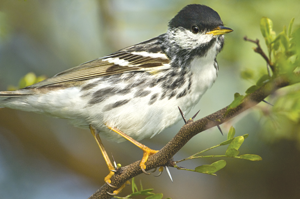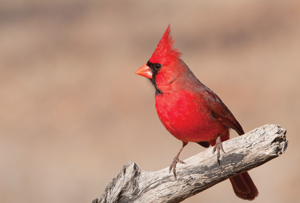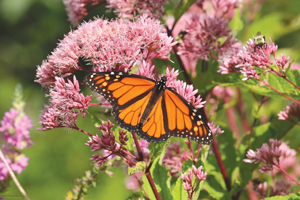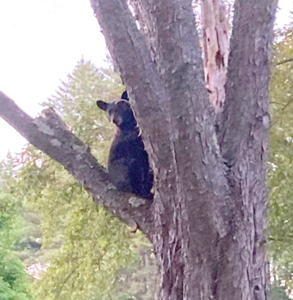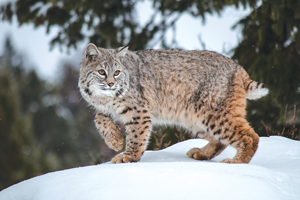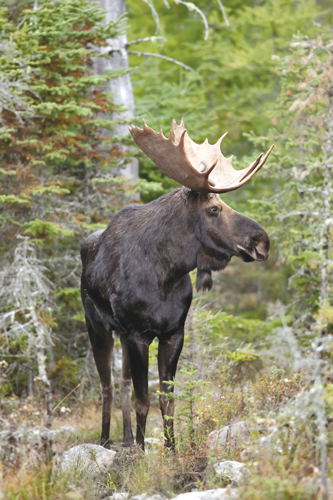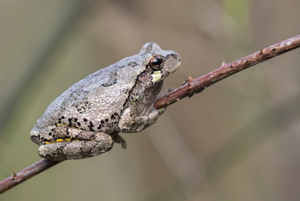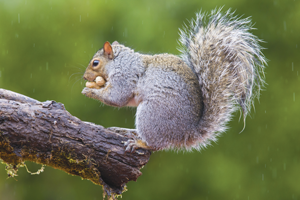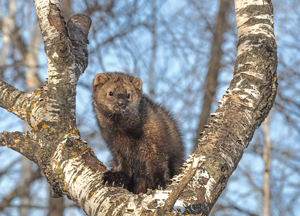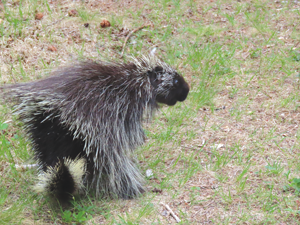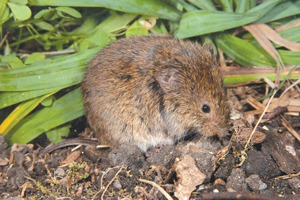Hovering hummingbirds, colorful salamanders, the occasional porcupine and more neighborhood wildlife
Curious about the wildlife you’ve seen during your neighborhood hikes and backyard hangouts? Rebecca Suomala, a biologist for New Hampshire Audubon, and Lindsay Webb, wildlife educator for New Hampshire Fish and Game, shared fun facts about 22 birds, insects, mammals and reptiles you might see in the nature around you.
By Matt Ingersoll & Angie Sykeny
Birds
Blackpoll warbler
Most likely seen during the summer into early September, especially in spruce-fir forests
“Blackpoll,” Suomala said, refers to the black cap of this bird seen in males, similar to that of a chickadee or a goldfinch. Blackpoll warblers are characterized by their white breasts, black streaks and yellow feet. They also weigh less than half an ounce. Beginning in September, these birds make long-distance migrations, flying non-stop over the Atlantic Ocean for nearly 2,000 miles before reaching their wintering grounds in South America.
Northern cardinal
Most commonly seen at lower elevations
According to Suomala, the northern cardinal is the only species of cardinal you’ll find in North America. Over the past several decades the species has extended its range farther north, and it’s now found almost everywhere in the Granite State except in higher elevations. Males are bright red with a fat red bill, while females are a brownish color with red highlights and an orange-red bill. The northern cardinal is a year-round, non-migrating resident of New Hampshire.
Ruby-throated hummingbird
Most likely seen during the summer into early September
At around three to three-and-a-half inches long, the ruby-throated hummingbird, Suomala said, is the smallest bird that can be found in New Hampshire. It makes its home in the Northeast in the summer before migrating to Central America in the winter. Males have a bright red throat with feathers that are reflective in the sunlight. These birds feed on nectar from honeysuckle plants and cardinal flowers. According to Suomala, this hummingbird’s wings can flap up to 53 times per second and its heartbeat rests at 250 times per minute. A male can go into a dive at more than 60 miles per hour.
Insects
Green darner dragonfly
Most likely seen in your backyard if you live on or near a body of water
Green darners are among the largest dragonflies you’ll see in the Granite State, growing up to three inches long, about the size of a hummingbird, with a wingspan of another three inches, Suomala said. You’re most likely to see them around water — these dragonflies migrate to the north in the spring and south in the fall. Females will typically lay their eggs on vegetation in or near the water. In its nymph phase (or larva phase) it lives entirely underwater, feeding on insects, tadpoles and small fish, before the dragonfly emerges out of the water as an adult.
Luna moth
Not likely to see them often; your best chances are at night, or around big lights, in June or July, when the adults emerge from their cocoons
These bright green moths, according to Suomala, are commonly known as giant silk moths because of their size, which can be as large as seven inches with a wingspan of four-and-a-half inches. They used to be very common in New Hampshire, but their population has since declined. If you live in a city you’re less likely to see them, because the caterpillars feed on trees like white birches and hickories. Caterpillars will eat all summer before they spin a cocoon, where they spend the winter before emerging in June or July.
Monarch butterfly
Very likely to see them at the peak of summertime and into the early fall
Monarch butterflies are characterized by their large orange and black markings. According to Suomala, they spend their winters in Mexico, but the same butterflies don’t make it all the way back up north. In fact, it takes about three generations for them to return to New Hampshire in the summer. The caterpillars feed on milkweed and eventually make a chrysalis, which takes them about 8 to 15 days to hatch from.
Large mammals
Black bear
Common, with an increasing population throughout New Hampshire.
Black bears are omnivores, eating with the seasons whatever they can find. “They have a great memory and sense of smell, so keep your trash locked up tight and reduce other bear food sources such as pet food, bird seed, and keep your grill cleaned up and secured,” Webb said.
Bobcat
Sightings have been on the rise in recent years, especially in the southern part of the state
According to Webb, the bobcat gets its name from its “bobbed” tail, which is shorter than the tails on most domesticated cats. The average length of a bobcat tail is around six inches but can reach up to 10 inches. A mother bobcat may raise a litter of two to four kittens in the spring. Elusive and lovers of solitude, these nocturnal feline predators are always on the hunt for rabbits, squirrels, mice, chipmunks and birds, Webb said, adding that they can swim and have little hesitation going into the water in pursuit of their prey.
Moose
Reside throughout New Hampshire, but are most commonly seen in the northern part of the state
Moose are active all day but do most of their moving around in the early morning or late afternoon, when the temperatures are cooler. They’re also, according to Webb, “pretty good swimmers.” “They love to feed on wetland plants and will dive down under the water to get at aquatic vegetation,” she said.
White-tailed deer
Common throughout New Hampshire in a variety of habitats, such as fields, farms, neighborhoods and woodlands
Though white-tailed deer prefer to hide out in the woods, they often make an appearance along woodland edges of towns and cities and in many farming communities. “In the summer, you may be lucky to see a fawn curled up in some tall grass or in a hidden spot in the woods,” Webb said. “Don’t be alarmed; this young one is not abandoned. Fawns are left alone for long periods of time while their mother goes off to feed and lead predators away, but she will come back for her fawn.”
Reptiles and amphibians
Gray treefrog
Much more likely to be heard than seen
Despite their name, gray treefrogs have the ability to change their color to match their background, from black to almost white or even a greenish-gray. Suomala said you can identify them by their trilling call at night. They are year-round natives of New Hampshire, hibernating underground. In fact, about 40 percent of a gray treefrog’s body can freeze — it can survive freezing temperatures by producing its own glycerol that’s circulated through its bloodstream and vital organs.
Painted turtle
This is the most commonly found species of turtle in the state
You can find painted turtles statewide, anywhere there are ponds. They reach a maximum length of just over seven inches; according Suomala, their sexual maturity is determined by the length of their shell, not by how old they are. Males require a length of at least three inches before they can reproduce, whereas for females, the required length of their shell is about four inches. If you see a turtle moving away from a pond, don’t move it in the direction of the water; Suomala said this is because female turtles are moving toward an area with sand or loose soil to lay their eggs. Painted turtles are also year-round residents of the Granite State, hibernating below the mud in the bottom of ponds.
Red eft salamander
Most likely found in damp, rainy conditions
Also known as the red-spotted newt, this amphibian has two different stages, according to Suomala — a water stage where it is characterized by its olive-green color with red spots, and a land stage, where it’s a bright orange-red color. You’ll most likely see them on land if you’re walking on a trail just after it has rained, she said. The female will lay its eggs underwater. Once the salamander reaches the land stage, it spends the rest of its life that way, for about two to three years.
Small mammals
Beaver
Common throughout New Hampshire in ponds, lakes and other wetlands
“If you’re lucky to have a lake or pond in your backyard, beavers might be a common sight for you,” Webb said, adding that, if you see one beaver, a whole family, consisting of anywhere from three to eight beavers, probably isn’t too far away. They can be difficult to spot as their dark brown fur blends in well with dark water, but there is “no mistaking the ‘slap’ of their tail when they feel threatened,” Webb said. Beavers leave a lot of clear evidence of their presence, including chewed stumps along the edges of bodies of water; stick dams that hold back water, creating deeper ponds; and stick lodges that extend down into the water. They may also build their lodges on islands or along the shore.
Eastern chipmunk
Common throughout New Hampshire, in woodland edges and forests
Though similar to squirrels, chipmunks can be differentiated by their size — they are a bit smaller than squirrels — and by their coloring, which includes brown fur with black and white stripes that run down their backs. According to Webb, chipmunks also have extra skin in their cheeks, allowing them to expand their mouths to carry more food back to their burrows. They often build their burrows at the base of a tree or under a stone wall. In the winter they spend most of their time sleeping, waking up every few days to eat from their stockpile of food. In a good year, when food is abundant, chipmunks can produce up to two litters of pups. “If you see a lot of chipmunks this year, you can bet that food availability was really high the previous year,” Webb said.
Eastern cottontail
Common in southern New Hampshire, often seen nibbling on clover and grass in backyards and parks
Eastern cottontails have multiple litters a year. In New Hampshire, they can have up to four or five. The mother cottontail builds a small shallow nest in the grass, well-disguised, with dead fern leaves covering the hole. “She only visits [the nest] a few times a day, so if you find a nest of kits — baby cottontails — just leave them be,” Webb said. “They are not abandoned; their mother will be back soon.” A rarer species of cottontail, the New England cottontail, can also be seen within a smaller range, restricted to the southern part of the state.
Eastern gray squirrel
Common throughout most of New Hampshire in woods and neighborhoods with plenty of deciduous trees
While gray squirrels have, as their name implies, mostly gray fur, there can be some variations in color. “Melanistic gray squirrels are black in coloration and albinistic gray squirrels look white,” Webb said. “Sometimes, small localized populations of black squirrels show up and persist for a few years. Gray squirrels often bury more acorns and seeds than they can recover, facilitating seed dispersal and resulting in the growth of many new trees every year.
Fisher
Most likely found in forested areas
Fishers — or “fisher cats,” if you prefer — are not actually cats. According to Suomala, they’re part of the mustelid (or weasel) family, with brown fur, a long tail and a pointed nose. They have a reputation for emitting a loud, caterwauling scream. But in reality, Suomala said, this sound is more likely made by a fox, while fishers are generally silent, instead occasionally making low chuckling or hissing noises. They’re the only animal in the state that regularly targets porcupines.
North American porcupine
Most likely seen in forested areas, at night
One of nearly two dozen species of porcupines throughout the world, the North American porcupine is found throughout New Hampshire. According to NH Wildlife Journal, a publication from New Hampshire Fish & Game, porcupines are large rodents covered in around 30,000 sharp quills. These quills, Suomala said, are hollow hairs with barbed tips made of keratin. Some people believe porcupines have the ability to shoot or throw their quills. In reality, Suomala said, this is not the case, although they can raise their quills in self-defense. Porcupines are nocturnal animals that feed on woody vegetation. They do not hibernate in the winter.
Raccoon
Common throughout New Hampshire, in wetlands, woods, farmlands and neighborhoods
Raccoons often do their food hunting, with much success, in human-populated areas and claim their den sites under porches and sheds. In fact, raccoon populations tend to be higher in cities than in their natural woodland and forest habitats. “Raccoons have easily adapted to the presence of humans and will gladly check your trash can for scraps of food,” Webb said. “[If] you’re battling a raccoon family this summer, keep your trash locked up tight or store it in a secure building instead of outside.”
Red squirrel
Common throughout New Hampshire in forests with plenty of coniferous trees
“These chattery squirrels are quick to let you know when you are bothering them with their red bushy tails raised, announcing themselves with loud trills, chatters and chips,” Webb said. Surviving on food they stashed during the winter months, the squirrels often forget to dig up all of their hidden seeds and nuts each year, which then grow into trees.
Vole
Especially likely to be found if you have a garden in your backyard
Not to be confused with moles, voles are small rodents that are experiencing a population boom in New Hampshire right now, according to Suomala. They look similar to mice, except they have smaller eyes and smaller ears. Voles are a nuisance in backyard gardens and orchards, but are actually a key food source for large birds like hawks and owls, as well as foxes and coyotes, she said. There are two types — meadow voles, and pine voles, which are slightly smaller, lighter in color and have a shorter tail than meadow voles. One female vole can produce four to eight litters per year, Suomala said, with about five young per litter.










